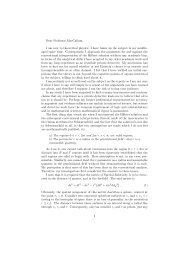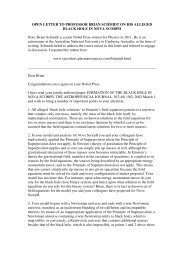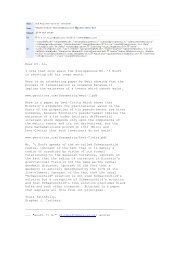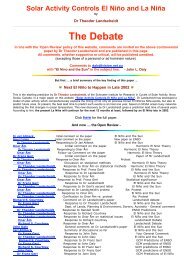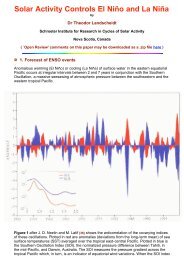Sun-Earth-Man - PlasmaResources
Sun-Earth-Man - PlasmaResources
Sun-Earth-Man - PlasmaResources
You also want an ePaper? Increase the reach of your titles
YUMPU automatically turns print PDFs into web optimized ePapers that Google loves.
time series of X-ray bursts comprising the same sampling intewaIs of half a<br />
month. The calculation based on the Burg-algorithm covers 312 data points<br />
and 301 frequencies. The filter length of 82 coefficients is in accord with the<br />
suggestion of most authors not to go beyond 30% of the number of data<br />
pointsq5' The extreme sensitivity of the MEM can lead to spectra1 shifts or<br />
spectrum instability, especially when the filter length is extended beyond 30<br />
to 40% of the length of the time series. Experiments with different filter lengths<br />
up to 40% show that the spectrum presented in Figure 17 is stable. There is<br />
no shift in the outstanding frequencies. The MEM spectrum shows the same<br />
prominent peaks at the same frequencies as in the Blackman-Tukey power<br />
spectrum. A narrower sampling interval of !4 month does not change the<br />
result.<br />
It is a disadvantage of the MEM that an acknowledged reliability test of<br />
spectra1 peaks does not yet exist. According to the simple and useful "rule of.<br />
thumb'' expressed by Stuart et a1. ,52 a spectral peak is regarded to be significant<br />
if it contains at leastthree computed points which deviate from the noise and<br />
has a maximum two or three times greater than the surrounding noise level.<br />
According to this standard the peaks in Figure 17 marked by period pointers<br />
deviate significantly from the noise. As these are the same peaks as in the<br />
Blackman-Tukey spectrum of Figure 16 that proved to be significant at<br />
confidence levels going up to %%,;here is sufficient evidence supporting their<br />
reality. A further replication is contributed by dividing the data set in klf. The<br />
maximum entropy spectra for each half again set off the peaks around 4.8,2.8,<br />
1.2, and I .I months; only the 156 months period is lost, as was to be expected.<br />
V. PLANETARY CONTROL OF THE SUNS'S MOTION 43<br />
V. PLANETARY CONTROL OF THE SUN'S MOTION ABOUT<br />
THE CENTRE OF MASS OF THE SOLAR SYSTEM<br />
The prominent cyclic features are consistently present in all spectra examined.<br />
Thus, there are sufficient reasons to propose the working hypothesis that the<br />
incidence of X-ray flares in the 1 to 8 A range shows a cyclic pattern. Where<br />
do these flare cycles come from? As to predictions, this is a crucial question<br />
because the analysis is based on the rather small time-span of 13 years. If there<br />
are strong variations in the actual period of cycles, forecasts of flares and<br />
connected terrestrial events will go astray if it is not clear which changes will<br />
o'ccur. It will be shown that the prominent amplitudes in the spectra indeed<br />
represent quasi-cycles with wide variations in their periods. The knowledge<br />
of the mean period of such quasicycles is no real help in predictions. The 12year<br />
sunspot cycle with a range of variation from 7 to 17 years is an example<br />
of this. As long as it is not known how the cycle is regulated, there will be no<br />
solid basis for predictions. Without a reasoned physical background to guide<br />
selection, there is a severe risk of finding accidental patterns in diverse and<br />
varied data sets. The statistical analysis of Fast data does not constitute a<br />
reliable means to foresee future change in the data pattern. Thus, it is of both<br />
practical and theoretical importance that the spectrum can be exactly related<br />
to thk variation in astrophysical quantities and to calculable planetary<br />
configumtions by an approach following the fundamental rule of Operations<br />
res lrch that the behaviour of any part of a system has some effect on the<br />
beKsyiour of the system as a whole. The results were tested by extended<br />
forecast experiments described above.<br />
The first process involved are impulses of the torque (IOT) in the <strong>Sun</strong>'s<br />
motion about the centre of mass of the solar system (CM) that were mentioned<br />
already. They are induced by special heliocentric consteIIations of the giant<br />
planets Jupiter, Saturn, Uranus,.and Neptune. Figure 18 shows the ecIiptic<br />
positions of CM relative to the <strong>Sun</strong>'s centre for 1945 to 1995. The heliocentric<br />
representation and the line marking the limb of the <strong>Sun</strong> make it easy to see<br />
whether CM is to be found above or below the <strong>Sun</strong>'s surface; most of the time<br />
it is on the outside of the <strong>Sun</strong>'s body. The distance of both centres varies from<br />
0.01 to 2.19 solar radii. It takes 9 to 14 years to complete one revolution. In<br />
relation to the galactic centre only CM follows an elliptic path around the centre<br />
of mass of the Milky Way system, whereas the <strong>Sun</strong> describes a very irregular<br />
helix around the elliptic line of motion of CM. The planets' paths are still more<br />
complicated. There is mutual interdependence. While the planets make the<br />
<strong>Sun</strong> oscillate around CM, the <strong>Sun</strong> induces a still more intricate dance of the<br />
planets about the centre of mass of the solar system. Newton was the first to<br />
see this: "Since that centre of gravity is continually at rest, the <strong>Sun</strong>, according<br />
to the various positions of the planets, must continually move every way, but<br />
will never recede far from that ~entre."~ In 1928 Ludwig Zehnder " suspected<br />
a connection of the <strong>Sun</strong>'s motion with the 1 1-year sunspot cycle. Paul D. Jose "5<br />
made a thorough computer analysis of this special relation in 1965.<br />
Unforhnately, h~s predictions for the 11- year sunspot cycle No. 21, based on<br />
his analysis, failed to be accurate.



